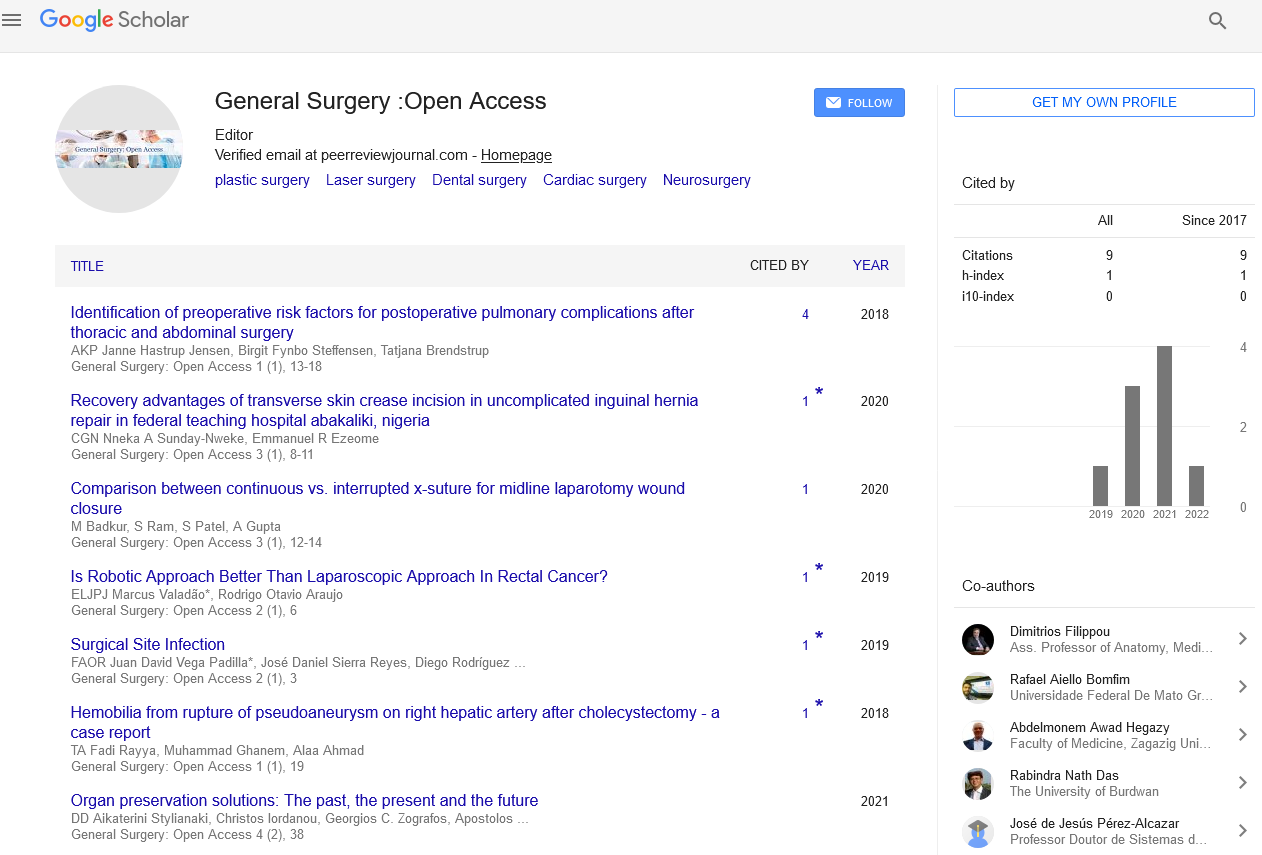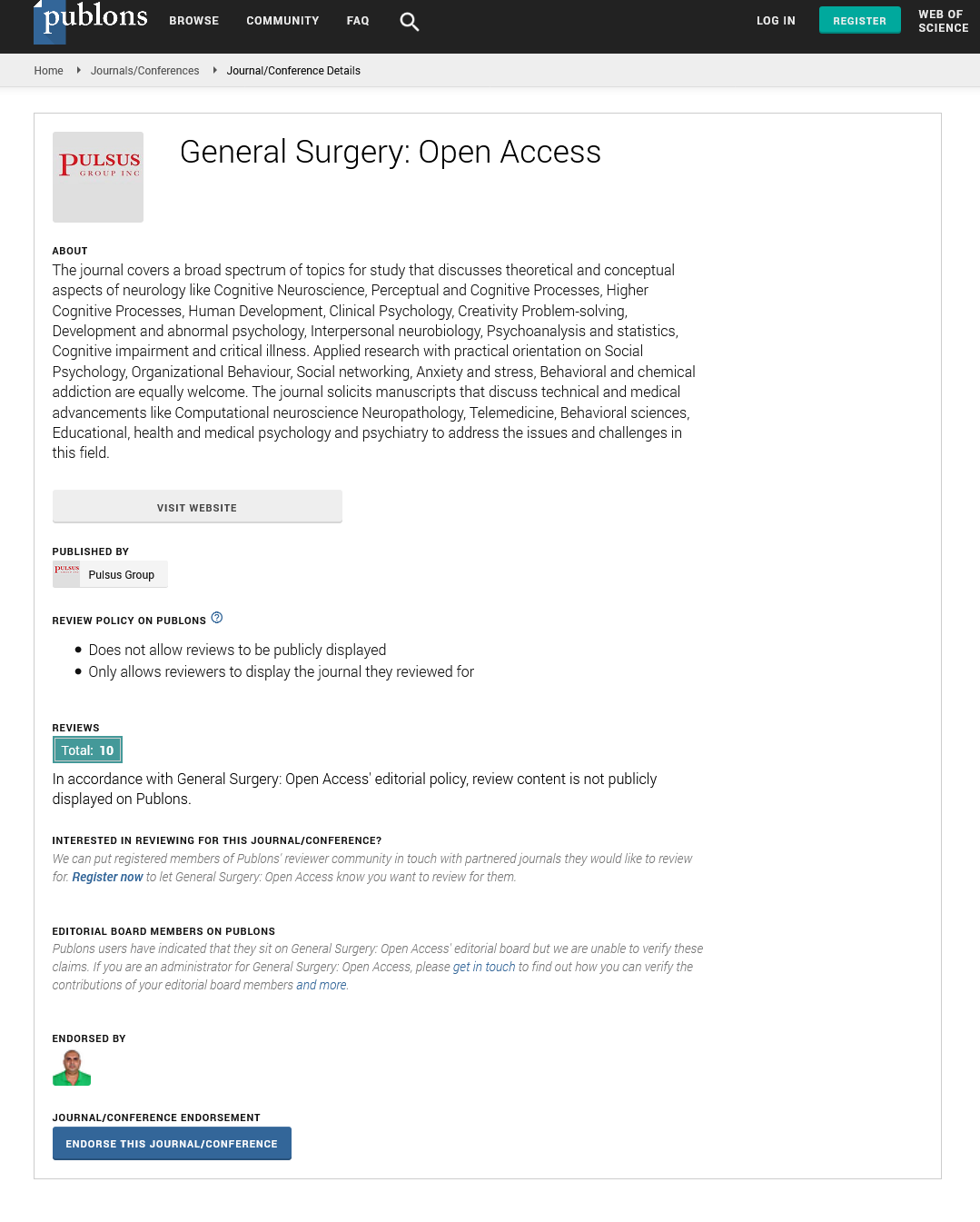Tracheotomy in ventilated victims with Coronavirus
Received: 05-Jul-2021 Accepted Date: Jul 19, 2021; Published: 26-May-2021
Citation: Singh L. Tracheotomy in ventilated victims with Coronavirus. Gen surg: Open Access. 2021;4(4):43.
This open-access article is distributed under the terms of the Creative Commons Attribution Non-Commercial License (CC BY-NC) (http://creativecommons.org/licenses/by-nc/4.0/), which permits reuse, distribution and reproduction of the article, provided that the original work is properly cited and the reuse is restricted to noncommercial purposes. For commercial reuse, contact reprints@pulsus.com
Description
The epic (COVID-19) worldwide pandemic is described by quick respiratory decompensation and ensuing requirement for endotracheal intubation and mechanical ventilation in serious cases with numerous likewise upholding the evasion of non-intrusive positive pressing factor ventilation like high-stream nasal cannula, Bilevel Positive Aviation Route Pressure (BiPAP), and pack concealing as they increment the danger of transmission through age of aerosols.
Here we try to decide if there is a subset of ventilated patients for which tracheotomy might be demonstrated, while thinking about tolerant visualization and the dangers of transmission. Suggestions may not be fitting for each organization and may change as the current circumstance develops. The objective of these rules is to feature explicit contemplations for patients with on an individual and populace level. Any aviation route system builds the danger of openness and transmission from patient to supplier. In such a quickly heightening pandemic, the point in treating patients with COVID- 19 illness is to augment the probability of recuperation for the best number of patients as fast as conceivable in a manner that limits the danger to the supplier. In these quickly evolving times, the "standard" of care may not be one to which suppliers are acclimated, yet the creators feel that it is basic to apply and cautiously adjust the best existing proof on this subject to the current pandemic. As seen in different nations who are experiencing ventilator deficiencies from a quickly speeding up number of cases, an abbreviated ventilator prerequisite and emergency unit of stay might be helpful in the designation of restricted assets.
If a tracheotomy is considered significant in a COVID-19 patient, an open careful tracheotomy is suggested over a Percutaneous Dilatational Tracheotomy (PDT) for the minimization of airborne age. Percutaneous Dilatational Tracheotomy may likewise be thought of if the patient has good life systems; notwithstanding, performing PDT with bronchoscopic direction may expand aerosolization through the bronchoscope port. There are a few fundamental contemplations for preoperative arranging, intraoperative methodology and postoperative consideration.
Tracheotomy is broadly utilized in concentrated consideration units, though with incredible inconsistencies between clinical groups as far as recurrence and methodology. Signs and procedures are, nonetheless, related with variable degrees of proof dependent on inhomogeneous or even conflicting writing. Our point was to direct a methodical investigation of the distributed information to give rules. We present thus proposals for the utilization of tracheotomy in grown-up basically sick patients created utilizing the Grading of Recommendations Assessment, Development, and Evaluation (GRADE) Technique. These rules were directed by a gathering of specialists from the French Intensive Care Society and the French Society of Anesthesia and Intensive Care Medicine with the investment of the French Emergency Medicine Association, French Society of Otorhinolaryngology. Sixteen specialists and two facilitators consented to consider questions concerning tracheotomy and its reasonable execution. Five points were characterized: signs and contraindications for tracheotomy in concentrated consideration, when a tracheostomy is not, at this point required, it very well may be eliminated and permitted to mend all alone, or the doctor may close it carefully. Patients can be released home with a trach with that comes new learning encounters. A prepared respiratory advisor or an expert medical attendant will help you and your family figure out how to really focus on the trach. Intubation (or being intubated) is the interaction where a breathing cylinder is put into the mouth and down the throat to give oxygen through a machine. Intubation is done when one can't keep up with their aviation route all alone because of sedation or sickness. Frequently, an individual is intubated for a brief time frame, and an individual would not return home when they are intubated. Patients can't be released with intubation and should have clinical oversight.






